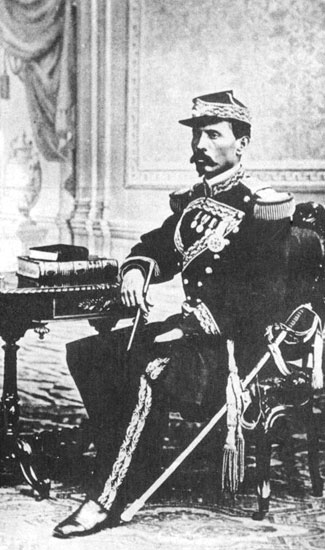Porfirio Diaz
Porfirio Diaz remains one of the most despised and enigmatic figures in Mexican history. Born in the state of Oaxaca and later a pupil of Benito Juarez, Diaz distinguished himself as a soldier in the Liberal armies. Already a general during the War of the French intervention, he became nationally famous after leading the charge that routed the French at Puebla. But following two unsuccessful presidential campaigns, Diaz abandoned liberalism and worked to overthrown the Mexican government. He began with an 1875 visit to New York City to enlist the support of U.S. investors who wanted greater access to investment opportunities in Mexico.
Diaz then proceeded to south Texas, where he raised several hundred thousand dollars from private supporters to train a small army. With this army, Diaz crossed the river and took Matamoros with little resistance on April 1, 1876. From then until 1910, a period known as the Porfiriato, Diaz ruled México with an iron fist. Although he took pride in the massive construction of railroads and development of mines, that growth was achieved at fearsome cost. Diaz suppressed the civil liberties guaranteed in the Constitution of 1857, and evicted literally millions of Mexicans from their lands and homes to make way for commercial developments. By 1910, most Mexican citizens were poorer than they had been forty years earlier. This paved the way for the Mexican Revolution of 1910.
Listen
Porfirio Díaz sigue siendo una de las figuras más enigmáticas y denostadas de la historia de México: oriundo del Estado de Oaxaca y posterior discípulo de Benito Juárez, Díaz se distinguió militarmente en el ejército liberal y, ya como general durante la Segunda Intervención Francesa, adquirió renombre a nivel nacional después de encabezar la carga que expulsó a las tropas galas de Puebla. No obstante, después de dos campañas presidenciales sin éxito, Díaz abandonó el liberalismo y se concentró en derrocar al gobierno mexicano: empezó en 1875 con una visita a Nueva York para granjearse el apoyo de capitalistas estadounidenses que buscaban un mejor acceso a las oportunidades inversoras en México.
Se dirigió después al Sur de Texas, donde recaudó varios cientos de miles de dólares de donantes particulares para instruir a un pequeño ejército, con el que cruzó el río y tomó Matamoros el primero de abril de 1876, mediando escasa resistencia. Desde ese entonces y hasta 1910, gobernó México con mano de hierro, durante el período que se conoce como el «Porfiriato». Si bien Díaz se enorgullecía del espectacular desarrollo ferroviario y minero durante su mandato, ese crecimiento se alcanzó a un coste terrible, pues se suprimieron las libertades civiles garantizadas por la Constitución de 1857 y millones de mexicanos fueron desahuciados de sus viviendas y tierras, expropiadas para abrir paso a las explotaciones comercial. Para el final de su régimen, la mayor parte los mexicanos era más pobre de lo que habían sido sus predecesores cuarenta años antes, lo que allanó el camino para el estallido de la Revolución Mexicana en 1910.

